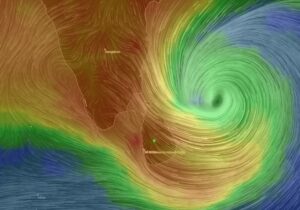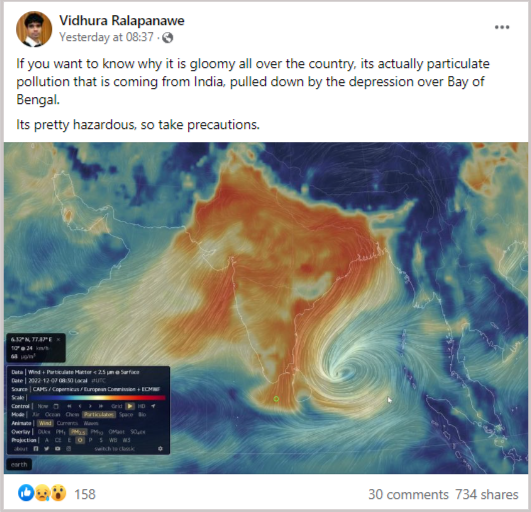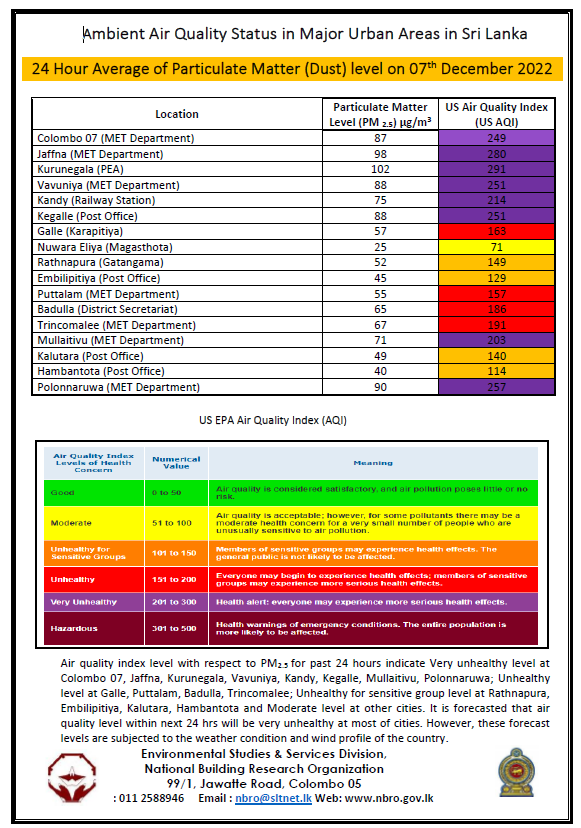Physical Address
23,24,25 & 26, 2nd Floor, Software Technology Park India, Opp: Garware Stadium,MIDC, Chikalthana, Aurangabad, Maharashtra – 431001 India
Physical Address
23,24,25 & 26, 2nd Floor, Software Technology Park India, Opp: Garware Stadium,MIDC, Chikalthana, Aurangabad, Maharashtra – 431001 India

Some of the world’s biggest countries and largest economies have been the main contributors to global emissions historically. Smaller countries with weaker economies usually emit much lower amounts of greenhouse gases and polluted particles.
Yet, the least developed, developing, and other vulnerable countries have suffered serious climatic loss and damages, compared to the industrialized countries because of the disproportionate impacts of climate change. This was one of the main topics during COP27 as well.
Like many small island nations, Sri Lanka is also on the receiving end of these adverse climatic events. Air pollution from neighbouring countries affecting Sri Lanka has been a hot topic of discussion in recent times, with many social media posts about the deteriorating air quality in the island nation and advisory measures, as the clear skies in Colombo and many cities in Sri Lanka turned gloomy.
An expert on renewable energy and climate change, Dr Vidhura Ralapanawa, posted the below image explaining the context of the current air quality situation of the country Sri Lanka.
“If you want to know why it is gloomy all over the country, it’s actually particulate pollution coming from India, pulled down by the depression over the Bay of Bengal. It’s pretty hazardous, so take precautions.”

Factcrescendo Sri Lanka team and the Climate Fact Checks team investigated the reasons behind this phenomenon.
First, we contacted Dr Vidhura Ralapanawa, who explained his stance on the current risky AQI (Air Quality Index) values of Sri Lanka.
He says that the gloominess seen in many parts of the country is influenced by the particulate pollution that`s coming mainly from the massive landmass from the Indian Peninsula due to the Northeastern Monsoon, and the current depression in the Bay of Bengal intensifies the situation.
However, Dr Ralapanawa added that this air pollution issue has been occurring seasonally with the onset of the Northeastern Monsoon`s wind patterns.
Three reasons are causing this situation, Dr Ralapanawa said.
“The dust particles would continue to prevail in the wind during the next few months (November-December to next year’s February-March) due to the dry nature of the wind. And also, Indian farmers burn their agricultural lands in these months after harvesting. Another reason is wind waves which come from Iranian deserts through Bangladesh.”
However, Dr Ralapanawa further stated that the current situation is different from this annual phenomenon.
“Currently, there is a cyclonic event in the Bay of Bengal, and that’s why those dust particles are being attracted to Sri Lanka due to the unusual behaviour of wind waves.”
He further stated that the current smog over many towns of Sri Lanka includes four types of particles from the Indian side.
“One is particles that are related with Indian coal power plants, another is industrialized waste products, along with the regular pollution related particles created by public and dust particles.” he elaborated.
And Dr Ralapanawa warned that this could become a more significant issue affecting public health as these particles can enter the human body via the respiratory system and cause-specific health issues.
However, he insisted that the situation would not prevail too long and that it would be sorted out with the end of the depression or cyclone in the Bay of Bengal within a few days.
We also contacted Sarath Premasiri, a senior scientist of the air quality unit of the National Building Research Organization of Sri Lanka.
He said that according to today’s and tomorrow’s data, the air quality levels are highly deficient in many areas of Sri Lanka, ranging between 150 – 200, which is unhealthy. He also attributes this to the particles coming from the Indian peninsula along with the windy weather conditions.
“These dust issues have been happening in the Monsoon season for years. But the situation of this particular moment is different and intensive due to the depression of the Bay of Bengal.”, he said.
Sarath Premasiri added that NBRO had not released any warning announcement about the ongoing event. However, they are trying to inform the people via media.
“Even in previous years, we noticed higher AQI values, that not healthy for Sri Lankans. However, he said that numbers these days are exceptionally high due to this cyclonic influence “.
NBRO director also requested that the public should wear masks outside and be safe from air pollutant particles.
The Indian Meteorological Department issued a warning on the 8th Dec evening for the Southern coastal cities of India over the cyclonic storm “Mandous”. As this intensifying condition is expected to bring strong gusts of winds Sri Lanka Met Department also issued a warning for the Northeastern, Northern and Western Coastal areas of Sri Lanka, as seen here.
“Due to low air quality levels in several areas in Sri Lanka, children, elders & those suffering from respiratory ailments & allergies are advised against going outside & if doing so wearing face masks.” – Dr Anil Jasinghe, Secretary Environment Ministry, requested from the Sri Lankans.
Sri Lanka College Pulmonologists also said they are well aware of the current situation and urge people to follow health guidelines like wearing masks.
We also checked past reports of deteriorating air quality in Sri Lanka and noticed that the levels have increased during the past months; every year, there has been an upward trend around November – January, as seen in 2019 and 2020 as well.
In 2020, an unprecedented surge in air pollution in Sri Lanka was noticed around the same period. Much blame was directed towards winds from India’s peninsular region blowing in high levels of bad air in strong gusts, as reported here. Archived
Fine particulates less than 2.5 micrometres in diameter (PM 2.5) are believed to pose the largest health risks. The U.S. EPA (Environmental Protection Agency) has developed a formula to convert the PM 2.5 readings into an air quality index (AQI). The higher the AQI value, the greater the level of air pollution and the greater the health concern. An AQI value of 50 or below represents good air quality, while an AQI value over 300 represents hazardous air quality.
However, an AQI level of over 150-200 (indicated in red) is also deemed unhealthy as some members of the general public could experience health effects, with sensitive groups prone to more severe health effects. An AQI of 200-300 is considered very unhealthy as “everyone may experience more serious health effects” More on this here.
As per the AQI data for some of the major cities in Sri Lanka for the past 24 hours, apart from Colombo, Jaffna, Kurunegala, Vavuniya, Kandy, Kegalle, Mullaitivu and Pollonnaruwa have recorded such very unhealthy levels of AQI index over 200, whereas Galle, Badulla, Trincomalee, Puttalam had recorded harmful levels as seen below.

The below chart shows the Air Quality Index in Colombo over the past month, indicating that the recent upward trend of high AQIs has been noticed since mid of November as per the data presented by U.S. EPA.

Many international air quality indexes also recorded unhealthy levels of AQI for Sri Lanka. Web| Archived| Archived, As a result, sensitive groups should take necessary steps to avoid exposure to polluted particles and a special holiday was declared for tomorrow (09th Nov) for all Government and Government approved schools island-wide, due to inclement weather conditions.
Dr Ravidra Kariyawasam says, “The highly toxic gases from the industrial cities have started blowing towards Sri Lanka with the change in the wind pattern. Also, when the wind direction changes, there are times when Colombo’s polluted air blows towards India as well. The problem is not the wind but the fact that industries continuously destroy the environment for the sake of high profits causing enormous damage to society. It is the same in India and Sri Lanka.”
“The air contains polluted particles and various larger particles of dust that travel with the air. In Sri Lanka, it is not even measured. Therefore, we should start the environmental and political discussion about the actions to be taken in this kind of disastrous situation in the South Asian region.” Environmentalist Dr Ravindra Kariyawasam added.
Let’s see how the worst air from other countries affects us.
Sri Lanka is surrounded by the Indian Ocean, the Gulf of Mannar, and the Palk Strait and lies in the vicinity of India and the Maldives. As we all know, India is currently a speedily developing country. With the incensement in industrial capacity, India led to release more and more greenhouse gases compared to others. On the other hand, “India is ranked in the fifth place among the countries with the worst air in the world”, reported IQAir India. It also mentioned that India has significantly unhealthy air at the end of the year.
This polluted air flows to and around Sri Lanka with the monsoon rains, end-of-year Christmas storms, and winds. Significantly, Sri Lanka has been experiencing this phenomenon from time to time in the last few years during the months between November to February. You can see the animation of how polluted air is classified and how it comes through winds here Archived.
The term “smog” is born with smoke and fog caused by polluted air. Today, most of the smog we see is photochemical smog. Photochemical smog is produced when sunlight reacts with nitrogen oxides and at least one Volatile Organic Compound (VOC) in the atmosphere.
Nitrogen oxides come from car exhaust, coal power plants, and factory emissions. VOCs are released from gasoline, paints, and many cleaning solvents. When sunlight hits these chemicals, they form airborne particles, ground-level ozone, or smog. More can be read from here Archived.
When considering Sri Lanka, all of the significant regions in the country have recorded high levels of particulate matter, PM 2.5 – (particles less than 2.5 micrometres in diameter). PM refers to a mixture of solid particles and liquid droplets in the air, including soot, dust, dirt, or smoke, and are visible to the naked eye. When PM is high, the “smog” or poor air quality may hide buildings from view from the horizon or appear as smoke in the atmosphere.
Once, Aljazeera recently reported that a thick layer of smog envelops New Delhi in the winter season and causes a surge in respiratory illnesses among its 20 million people.
A research study conducted by the National Building Research Organization (NBRO) stated that, per the air quality data obtained by air quality monitoring centres of the NBRO, in urban areas of Sri Lanka, “the air quality level of Sri Lanka has slightly deteriorated during these days due to the contribution of trans-boundary air pollutants from other countries with the prevailing weather conditions.”
Leading cities are experiencing this polluted air, causing severe health risks to citizens. Main cities such as Delhi and Kolkata in India, Lahore and Karachi in Pakistan, Hanoi in Vietnam and Dhaka in Bangladesh have recorded very high air pollution levels concerning delicate Particulate Matter (PM2.5). Air pollution, mainly soft Particulate Matter (PM2.5) from above-state-dated highly polluted areas, travels a longer distance with the wind and reaches the inland regions of Sri Lanka. The level of increased fine Particulate Matter is temporary and short-term. It highly depends on the meteorological conditions, especially the wind pattern cited by the national building research organisation Sri Lanka. You can read the research article here.
The severity of this situation is confirmed by the recent fatalities in India. India’s air pollution is worsening, and several areas have been locked down to manage this high-risk condition. Children, pregnant women and elders can be categorised as more vulnerable parties.
The distribution of world funding, military stock, knowledge and natural resources is controlled by the developed nations while developing countries have limits and insufficient financial capacity compared to developed nations. More can be read here; Climate mitigation capacity is comparatively low in developing countries. This situation is highly affecting Sri Lanka because of the prevailing economic crisis.
COP27 highlighted that developed countries must live up to their duty to lead by achieving zero emissions well before mid-century and must acknowledge that for poor and vulnerable developing countries.
At COP27, ministers and leaders from more than 40 Climate and Clean Air Coalition (CCAC) countries came together alongside many partners from intergovernmental organizations, businesses, scientific institutions and civil society organizations to announce new collaborative efforts, report actions undertaken at home, and reaffirm their commitment to slashing short-lived climate pollutants (SLCPs) for human and planetary health.
Comments are closed.
I am in fact thankful to the owner of thіѕ websіte who has ѕhared this enoгmous paragraph at at
this time.